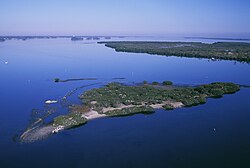Pelican Island National Wildlife Refuge
| Pelican Island National Wildlife Refuge | |
|---|---|
|
IUCN category Ib (wilderness area)
|
|
| Area | 5,376 acres (21.76 km2) |
| Established | March 14, 1903 |
| Website | Pelican Island National Wildlife Refuge |
| Designated | March 14, 1993 |
|
Pelican Island National Wildlife Refuge
|
|
 |
|
| Location | Indian River County, Florida, United States |
|---|---|
| Nearest city | Sebastian, Florida |
| Coordinates | 27°48′36″N 80°26′28″W / 27.81000°N 80.44111°WCoordinates: 27°48′36″N 80°26′28″W / 27.81000°N 80.44111°W |
| Area | 3 acres (1.2 ha) |
| Built | 1903 |
| NRHP Reference # | 66000265 |
| Significant dates | |
| Added to NRHP | October 15, 1966 |
| Designated NHL | May 23, 1963 |
Pelican Island National Wildlife Refuge is a United States National Wildlife Refuge located just off the western coast of Orchid Island in the Indian River Lagoon east of Sebastian, Florida. The refuge consists of a 3-acre (12,000 m2) island that includes an additional 2.5 acres (10,000 m2) of surrounding water and is located off the east coast of Florida of the Indian River Lagoon. Established by an executive order of President Theodore Roosevelt on March 14, 1903, Pelican Island was the first national wildlife refuge in the United States. It was created to protect egrets and other birds from extinction through plume hunting.
Pelican Island’s bird populations were threatened because of increased American settlement around the area in the mid-19th century. Many of the exotic birds were killed for their feathers, used in the fashion industry. Plumes from the birds were used to adorn ladies' hats of the day and at the time were worth more than their weight in gold.
Paul Kroegel, a German immigrant, moved to Florida in 1881 and lived on the west bank of Indian River Lagoon. He was fascinated with the pelicans on the island. Being able to see the island from his home, Paul would watch the pelicans and other water birds. He eventually took an interest in the island and its protection. However, there was not any state or federal law to help him so he took control of the situation himself. Kroegel sailed to the island to stand guard and protect the birds and the island.
A few naturalists visited Kroegel at Pelican Island. A curator at the American Museum of Natural History in New York, Frank Chapman, was one of the naturalists showing interest in the island as well. He discovered that Pelican Island was one of the last rookeries of Brown pelicans on the eastern coast of Florida.
...
Wikipedia


